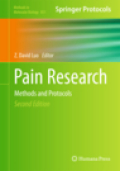
The advancements of medical technology, improvements in medical care, and increased patients’ life span make pain research and related drug development high priorities for both the research community and pharmaceutical companies. Rapid development of basic science research tools, such as techniques of flurometric labeling, genomic and proteomic high throughput screening, and geneticallymodified animals, promotes the swift acceleration of pain research to a stageallowing integrated investigations of pain processing mechanisms at the single cell and/or molecule level, and in a spatially and temporally controlled manner. Using multidisciplinary approaches, we can dissect the complicity of thesensory circuits connecting peripheral stimulation to maladaptive changes in the sensory pathways as well as pain perceptions at the central nervous system. Pain Research: Methods and Protocols, Second Edition provides advanced techniques and animal models that are critical for integrated pain research. Written in the highly successful Methods in Molecular Biology™ series format, chapters contain introductions to their respective topics, lists of the necessary materials and reagents, step-by-step, readily reproducible laboratory protocols,and notes on troubleshooting and avoiding known pitfalls. . Authoritative and accessible, Pain Research: Methods and Protocols, Second Edition serves as an ideal guide to novice pain researchers who may not have extensive experiences in the field, or to experienced pain researchers who would like to expand their research in new directions and/or to new mechanisms in different models. . Includes cutting-edge methods and protocols. Provides step-by-step detail essential for reproducible results. Contains key notes and implementation advice from the experts. INDICE: Advancements in Pain Research. Genomic Methods for Clinical and Translational Pain Research. Two-Dimensional Gel Electrophoresis: Discovering Neuropathic Pain-Associated Synaptic Biomarkers in Spinal Cord Dorsal Horn. Whole-Cell Patch-Clamp Recordings on Spinal Cord Slices. Whole-Cell Recording in Isolated Primary Sensory Neurons. Indwelling Supradural Catheters for Inductionof Facial Allodynia: Surgical Procedures, Application of Inflammatory Stimuli, and Behavioral Testing. An Experimental Model of Headache-Related Pain. A Rodent Model of Trigeminal Neuralgia. New Models of Experimental Parotitis and Parotid Gland Distension in Rats. A Rat Pain Model of Facial Cancer. Orofacial Pain Models and Behavior Assessment. Unilateral T13 and L1 Dorsal Root Avulsion: Methods for a Novel Model of Central Neuropathic Pain. A Lumbosacral Ventral Root Avulsion Injury and Repair Model for Studies of Neuropathic Pain in Rats. A Rat Chronic Pain Model of Spinal Cord Contusion Injury. The Spared Nerve Injury Model of Neuropathic Pain. A New Rat Pain Model of Thrombus-Induced Ischemia. Rat Models of Pancreatitis Pain. The Monosodium Iodoacetate Model of Osteoarthritis Pain in The Rat. K/BxN Serum Transfer Arthritis as a Model of Inflammatory Joint Pain. A New Rat Model of Bone Cancer Pain. Exposure of the Dorsal Root Ganglion to Pulsed Radiofrequency Current in a Neuropathic Pain Modelof Peripheral Nerve Injury.
- ISBN: 978-1-61779-560-2
- Editorial: Humana Press
- Encuadernacion: Cartoné
- Páginas: 306
- Fecha Publicación: 28/02/2012
- Nº Volúmenes: 1
- Idioma: Inglés
